School of Graduate Studies (SGS) - Graduate Student Experience & The Medicine Wheel
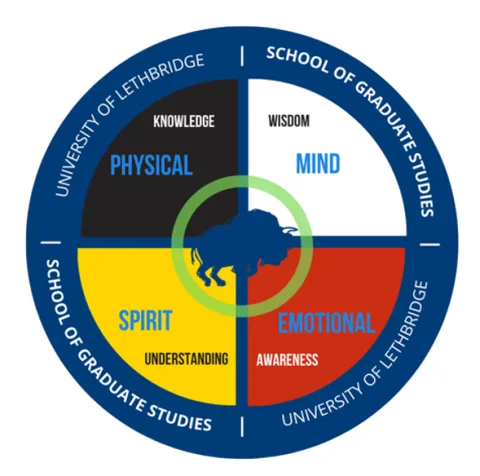
The School of Graduate Studies’ Story: Holism in the Graduate Student Journey
The School of Graduate Studies strives to support all aspects of the graduate student experience. While your academic work may be the primary focus of your graduate program, we encourage you to think holistically about all components of your graduate student experience, and how they will support your future experiences after the completion of your program.
The graduate student's journey is often represented by four stages: orientation, course work, projects/thesis, and thesis defence/capstone completion. It also represents the four needs of students' holistic journey during their time in graduate school: physical health, mental health and wellbeing, community/spiritual needs, and emotional wellbeing. We at the School of Graduate Studies wanted to encourage students to take the time to recognize and meet these needs during your program to avoid overextension and burnout.
The medicine wheel is an important Indigenous symbol that represents how all things in the natural world come in fours: four directions, the four seasons, the four basic elements, the four people, the four medicines, the four stages of life and the four states of being (physical, mental, spiritual, emotional). A powerful symbol of balance and wholeness, it is a perfect representation of the holistic approach we aim for in the graduate student experience at the University of Lethbridge.
It was incredibly important to the SGS team that such an important Indigenous symbol was incorporated appropriately. Initial learning began in 2022, and the SGS medicine wheel was created in 2023. Further consultation to learn more about medicine wheels and how they are understood on Blackfoot territory occurred during the 2024-2025 academic year. This important work was completed by an Indigenous co-op graduate student employed by SGS.
As we prepare to share the SGS Medicine with the broader ULethbridge community, the School of Graduate Studies remains committed to incorporating Indigenous epistemologies into our work. We are thrilled to see this prioritized in the University’s new Strategic Plan, and look forward to future collaboration and learning from our community’s Elders and Knowledge Keepers.
SGS Graduate Student Medicine Wheel
The graduate student medicine wheel recognizes the importance of balance and life cycles through their journey, which the medicine wheels teach about. Our medicine wheel consists of two circles: the larger circle that encompasses the four sections that represent the different aspects of a graduate student life; the centre circle, which represents the student; and the buffalo, which pays homage to the Blackfoot people who care for the land the graduate students reside and attend classes on as well as the elders and people who share their knowledge to create an environment of learning and wellness for all students of different walks of life, in different parts of their journey.
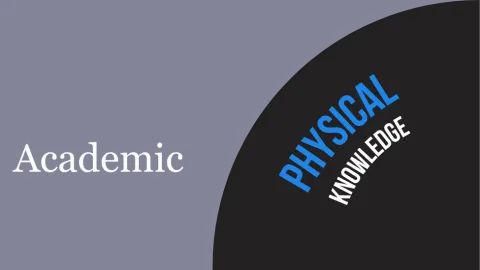
The black Section of the medicine wheel symbolizes the physical body and knowledge. Graduate students must know many essential things about or how to access services listed in this category. These help you navigate the university from your collective agreement, funding, advising and more.
Examples of resources within this category include all academic resources, advising resources, and funding.

The white section of the medicine wheel symbolizes the mind and wisdom. Services that branch under this section are there to support your learning and beyond through professional skills, academic skills, research skills, and more.
Resources under this section include all types of events (academic and professional), networking, and academic engagement.
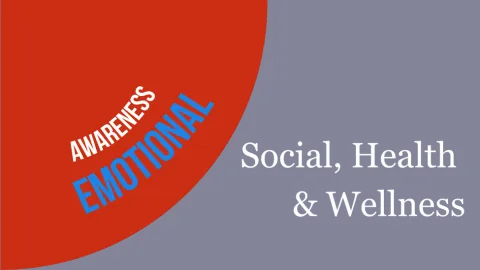
The red section of the medicine wheel, symbolizing emotions and awareness, is particularly important during this phase of your life. It's normal to feel a range of emotions during your graduate program, and the services in this category are designed to provide the support you need to work through them.
Resources within this category include self-care practices, resources that address your spiritual, mental, and physical health, and all supports that help you meet these needs, including external supports such as friends and family.

The yellow section of the medicine wheel, symbolizing spirit and understanding, is about fostering a sense of community. The services here are not just about connecting you with university events and groups, but also about providing spiritual support to take care of all your needs.
Services under this section include inclusion & belonging supports, ceremony, smudging, and social events.
Natasha's Story: Creation of the SGS Graduate Student Medicine Wheel
"The Journey Behind the Graduate Studies Medicine Wheel
The creation of the Graduate Studies Medicine Wheel has been a meaningful journey of collaboration, reflection, and learning. When we first began discussing how to visually represent the student experience throughout graduate studies, the medicine wheel immediately came to mind. I was reminded of the teachings shared by Knowledge Keepers, Elders, and Professors during my undergraduate studies—lessons that emphasized the importance of turning to the medicine wheel throughout all stages of life.
These teachings highlighted how the wheel evolves with us, offering guidance and reminding us to seek balance in our personal, academic, and spiritual growth. When I shared this vision with the School of Graduate Studies team, it became clear that this was a concept worth exploring further through collaboration—with Iikaisskini Indigenous Services and others across campus.
With my education coming from Anishinaabe and Cree backgrounds, traditionally adopted into East Prairie by Asiniy Iskwew (Earth woman) Jennifer Supernault. I also wanted to honour the Blackfoot people, whose traditional territory the University of Lethbridge resides on. This intention led to an incredible learning experience that included conversations with local Elders like Elder Frances First Charger, insights from Knowledge Keepers, the study of Indigenous archaeology, and visits to historic stone medicine wheel sites.
Standing at these sacred sites—listening, learning, and sharing in the stories held within the land—was deeply humbling. The knowledge gained through this journey will stay with me for a lifetime.
It’s my hope that this collaborative and culturally grounded representation will serve as a source of balance and inspiration for all graduate students as they navigate their own unique paths at the University of Lethbridge and beyond."

Natasha Randell-Tremblett: A Graduate Student Profile
"Nîpisîwâsaskwêtow Iskwew (Willow Fungus Woman) – Natasha Randell-Tremblett, BA (Hons)
Natasha Randell-Tremblett is a master’s student in Women and Gender Studies, currently completing her thesis on domestic violence shelter services in Alberta. She holds a Bachelor of Arts (Honours) in Gender & Justice and Indigenous Studies from Trent University, where she focused on anti-violence services, effective communication strategies and trauma-informed storytelling.
In addition to her academic work, Natasha is recognized for her contributions to The Smallest Steps documentary, which raises public awareness about gender-based violence. She has also been involved with Community Campus Engage Canada, where she supports anti-violence organizations in developing and managing impactful social media strategies."
Medicine Wheels: A Brief History
The following text was provided by Natasha and approved by Elders and Knowledge Keepers.
Indigenous people recognize, reflect and are influenced by the circular patterns of creation in our environment. These wheels are as diverse based on the first nations they represent and yet hold similar features and representations based on the circular patterns of creation in nature that each recognizes. (Bob Joseph Cited in APLC - Alberta Professional Learning Consortium, 2024)
The medicine wheel of graduate studies pays homage to three types of medicine wheel’s Cree, Ojibwe and Blackfoot. Everyone needs to understand that medicine wheels are not a pan-indigenous cultural practice. When discussing what represents a holistic representation of the graduate journey through the academic environment, reminding them that there are so many parts of the journey outside of simple course work and thesis, the medicine wheel was an excellent representation of this.
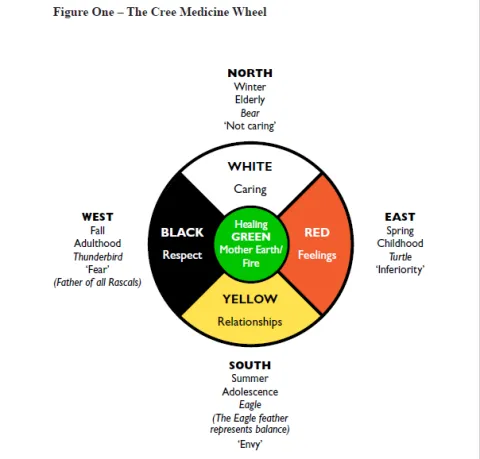
Wenger-Nabigon, A. The Cree Medicine Wheel as an Organizing Paradigm of Theories of Human Development, p. 145.
Cree medicine wheels are four/five sections of a circle, four coloured sections (red, yellow, white, black) with a centre area. Depending on which Cree first nation you speak with, the medicine wheel has a centre section considered fire/spirit representation. These sections represent four directions and different aspects of teachings depending on whether it is tipi or drum teachings, but all medicine wheel teachings connect with the focus of balance.
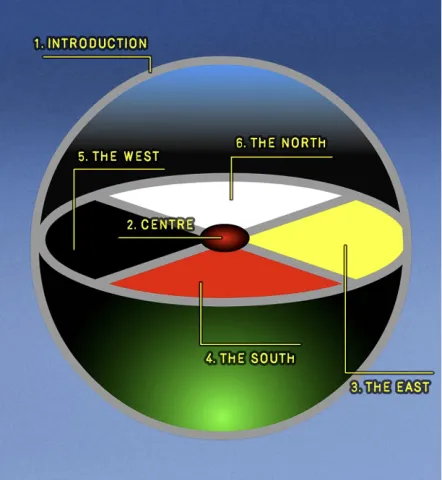
Elder Lilian Pitawanakwat. Ojibwe/Powawatomi (Anishinabe) Teaching (2006).
Ojibwe medicine wheels are four sections (black, red, white, yellow) with a green centre inside a larger circle, the top of the larger circle with the upper area representing the creator and the lower section representing the earth. These sections describe the seven directions of Ojibwe and connect to many teachings about different stages of life and balance.
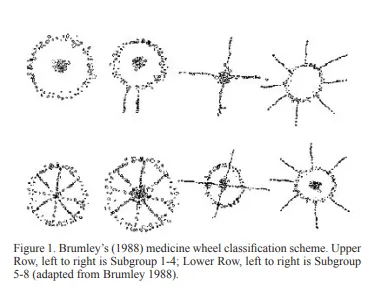
Pard et. A. (2016) The Blackfoot Medicine Wheel Project, p. 87
The Blackfoot stone medicine wheels (Ak’hstimani) are the most diverse of the medicine wheels, being the only ones made from stones that create permanent structures through time “only in Blackfoot territory” (Elder Frances First Charger, personal communication, July 17, 2024) primarily across Alberta, Saskatchewan, and Montana, with some in Wyoming, North Dakota, and South Dakota. These medicine wheels fall into eight categories depending on structural design, with many sub-designs depending on what they represent.
The medicine wheels are primarily designed with one or more circles, various spokes, and stone placements in shapes depending on what they represent. Some medicine wheels are designed for funerals to mark where a person died, with the circles and spokes being built around the tipi and body to mark the story of their life. Others marked significant actions or people, such as the Many Spotted Horse medicine wheel, which recognized the Chief Many Spotted Horse for his horses and raids (Elder Frances First Charger, July 17, 2024). “The North West Mounted Police note that in 1877 at the signing of Treaty 7, Many Spotted Horses had 300 pinot horses, 10 wives, and 31 children” (Pard et al., 2016, p. 93) his medicine wheel type 8, is one of the most recognized stone medicine wheels of the blackfoot confederacy.
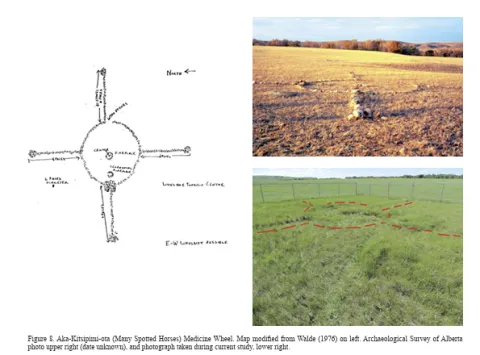
Pard et. Al (2016), The Blackfoot Medicine Wheel Project, p. 95.
Great Man Medicine Wheel, located not far from Many Spotted Horses, recognizes a warrior who went to war (Elder Frances First Charger, July 17, 2024). While not as well known, large in size, it is still a place to recognize and connect with Blackfoot culture.
Many believe that the stone medicine wheels have a celestial connection, focusing on the spokes of specific medicine wheels, such as types 5 and 6, which are aligned with star patterns or placements depending on the season. You can learn more about these connections at the Galt museum display, which discusses Blackfoot stone medicine wheels. Contemporary stone medicine wheels have been built over the years in Edmonton, Waterton and Lethbridge, including the one located at the Galt Museum, which was built by the leaders of the Blackfoot confederation ( Siksikaitsitapi) which include the Kainai, Piikani, Siksika and Amskapi Pikuni Nations on Sept 2016 (Nitsitapiisksakoo, 2022). This stone medicine wheel contains an inner and outer circle with four spokes, inside the outer circle within the sections are rock patterns that represent the buffalo footprints and the Blackfoot connection to the buffalo.

Nitsitapiisksakoo Landscapes Part 1. Galt Medicine Wheel.
These contemporary sites in urban areas are of vital importance for urban indigenous people who are connecting with their culture and play a key role in the resurgence of cultural practices within cities. Understanding and respecting them is essential; while we recommend that graduate students visit the Galt Museum site, we highlight the importance of understanding critical rules about visiting. These sites are where offerings are made, and it is recommended that when you go, you make an offering (Many Grey Horses as cited in The Importance of Medicine Wheels in Indigenous Culture | Tourism Lethbridge, 2022). These offerings can include Tobacco, sweetgrass, Sage, willow, 100% cotton cloth, Berries, and prayers; these items may be bundled in small cotton prayer bundles or laid on the rocks by themselves. Never touch or remove a bundle from a medicine wheel; this is disrespectful to the culture, but also, some bundles have been at medicine wheel locations since their creation. Never interrupt or take pictures of someone praying, singing or laying an offering within the medicine bundle. Never disturb, move or adjust the rocks of a medicine wheel.
References
APLC - Alberta Professional Learning Consortium (Director). (2024, March 8). Using the Medicine Wheel to Promote Wellness [Video recording]. https://www.youtube.com/watch?v=nkemQ-HYBWk
First Charger, E. F. Ninnaisipistoo (Owl Chief). (2024, July 17). Stone Medicine Wheels Interview [Personal communication].
Nitsitapiisksakoo: Nitsitapii Landscapes Part 1. (2022, February 18). Galt Museum & Archives. https://www.galtmuseum.com/exhibit/nitsitapiisksakoo-nitsitapii-landscapes
Pard, A., Child, J. W., Leg, C. W., Rider, B. F., Brewer, K., & Peck, T. R. (2016). The Blackfoot Medicine Wheel Project. Archaeological Survey of Alberta 36, p. 86-99.
Pitawanakwat, E. (2006). The Medicine Wheel Teachings. Historical and Contemporary Realities: Movement Towards Reconciliation.
The Importance of Medicine Wheels in Indigenous Culture | Tourism Lethbridge. (2022, May 3). Toursim Lethbridge. https://tourismlethbridge.com/stories/arts/the-importance-of-medicine-wheels-in-indigenous-culture
Wenger-Nabigon, A. (2010) The Cree Medicine Wheel as an Organizing Paradigm of Theories of Human Development. Native Social Work Journal, 7, 139-161.
